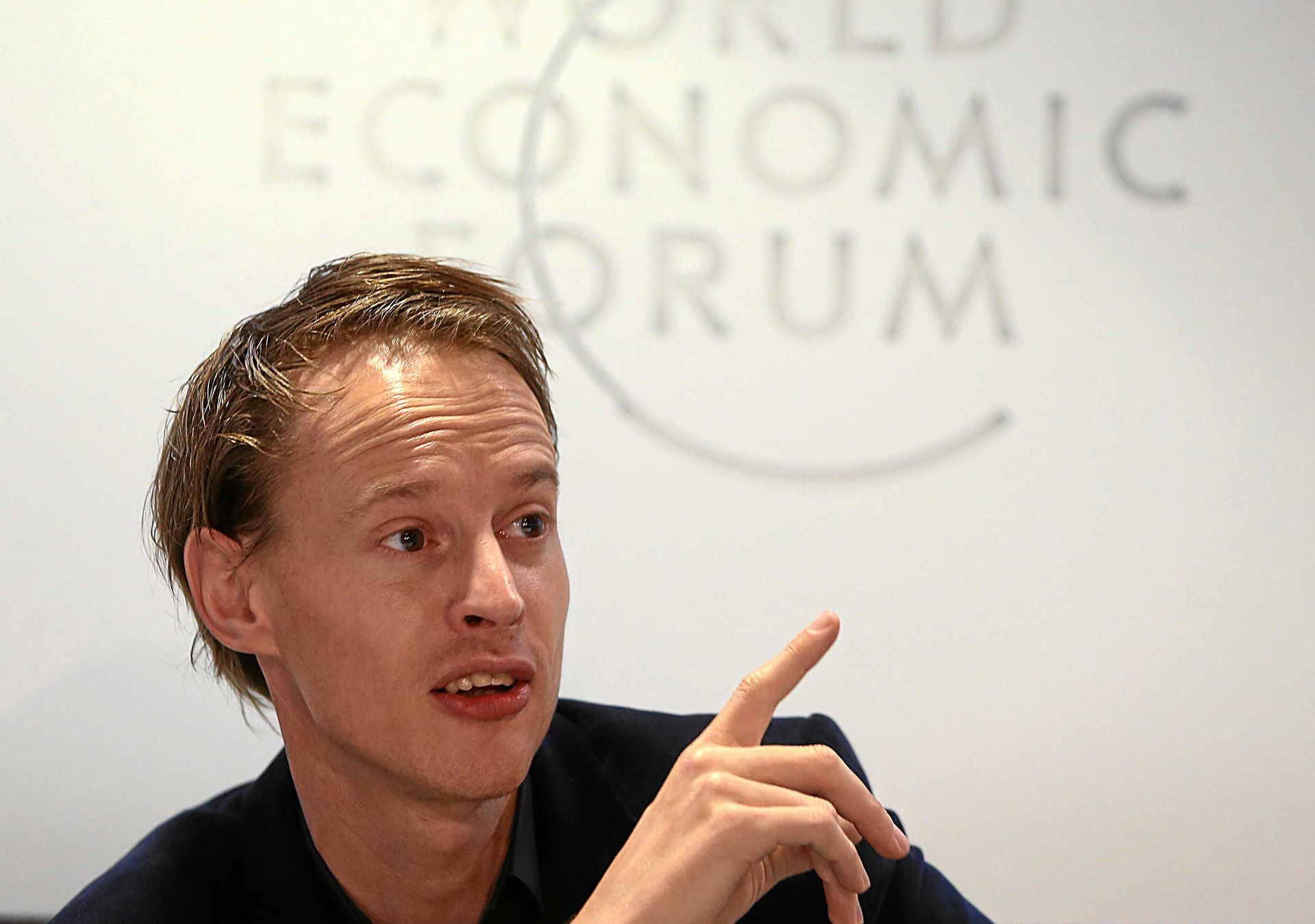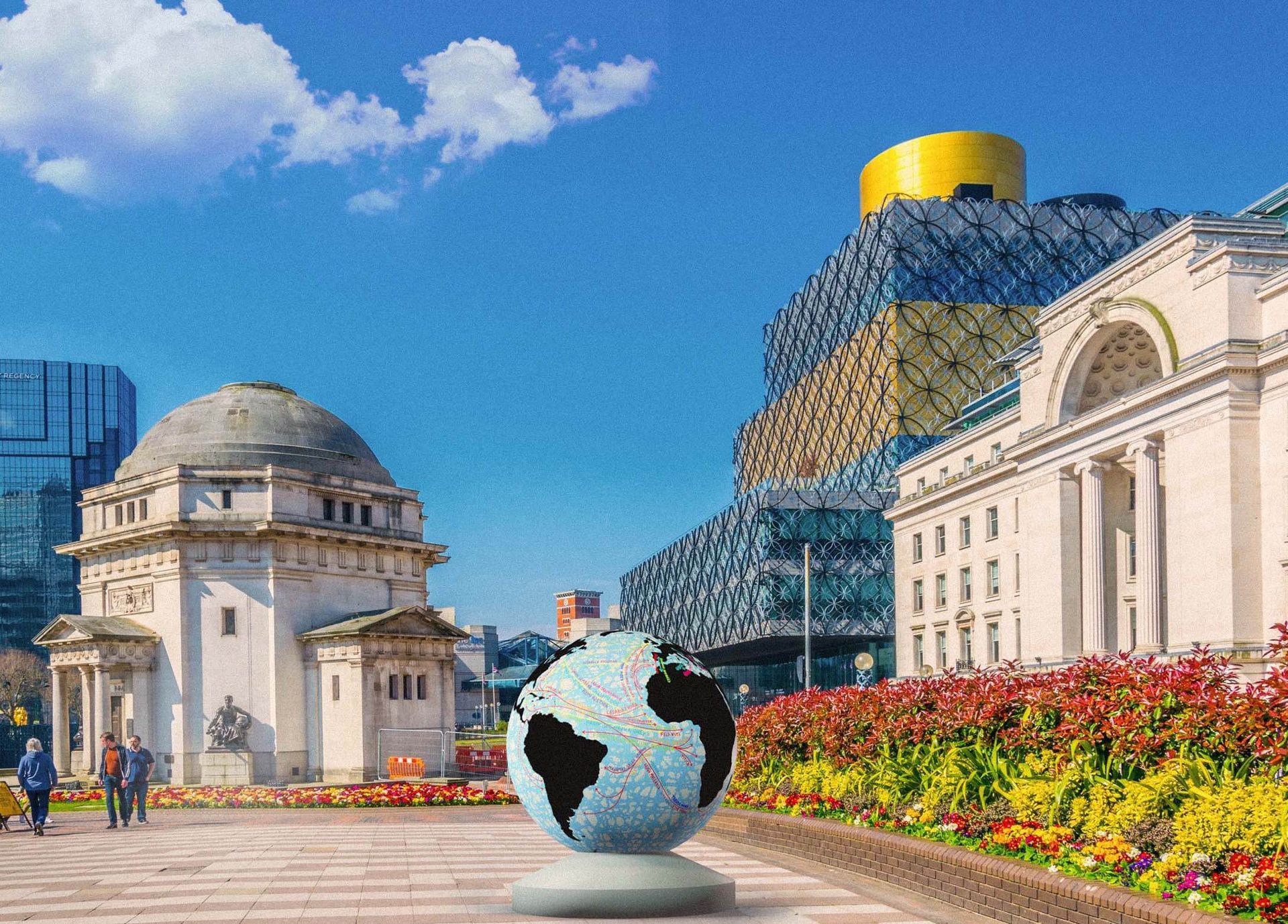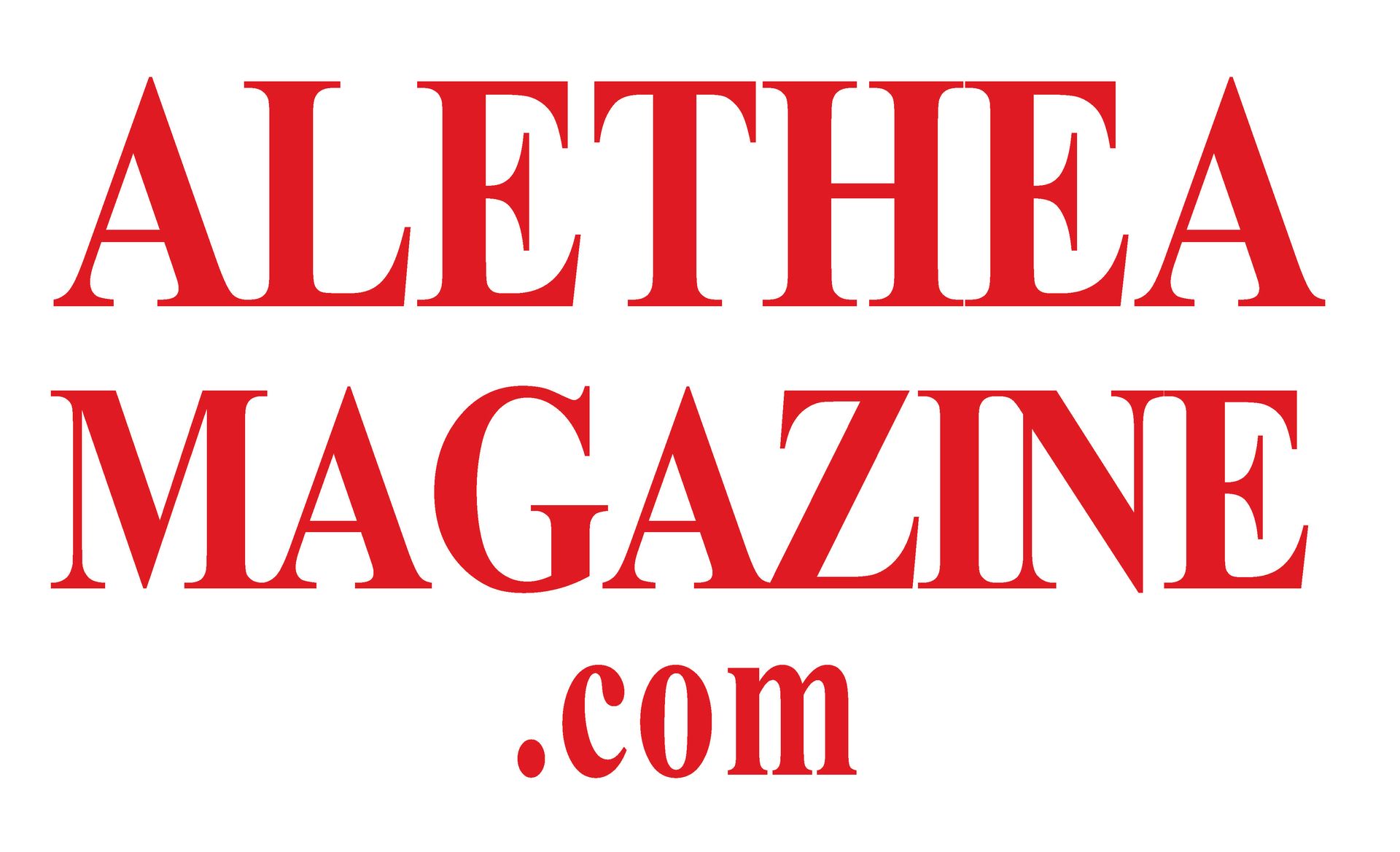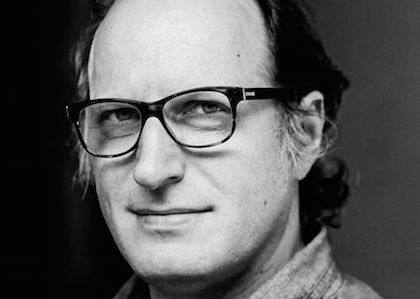
Christoph Pöggeler ©Oliver Look
Christoph Pöggeler: "The advertising column is a great means of communication - a jumble of social announcements."
Düsseldorf artist Christoph Pöggeler is known and loved for his "Säulenheiligen" (column saints), which stand on Düsseldorf's most prominent squares. He is currently having his second solo exhibition at Galerie Kellermann. His large oeuvre of paintings is on display there, with some of the paintings dating back to the 1980s. All the paintings are on wood, a material the artist has absolutely preferred for decades. When you see the paintings in the gallery, you can immediately see why, because the grain of the wood shines through the paintings and the pictures appear multi-dimensional.
Very early in his artistic career, Christoph Pöggeler began working with wood and found objects. At that time, the abbess of the St. Joseph Chapel on the Rhine in Düsseldorf asked him to do an exhibition and he exhibited painted sun loungers in the chapel. The interview is, of course, also about his popular "Säulenheiligen", who show so many different characters and stories that many a Düsseldorf resident has his or her very own column saint.
Alethea Magazine learns everything about the background of the various figures, from the businessman, the photographer, the bride, the kissing couple, and also what an artist has to take on to be able to exhibit his art in public space. Christoph Pöggeler tells us how he was inspired to create his first "Säulenheiligen" and what role Düsseldorf played in the process. The "Säulenheiligen" can be found all over Düsseldorf and the artist also has plans for more figures. You don't have to stop at admiring the "Säulenheiligen" from afar, because you can also have it in a small format for your home and, for the first time, in bronze.
Christoph Pöggeler grew up in Trier and Aachen and stayed by chance in Düsseldorf, a city that gives him much inspiration today. Alethea Magazine met the artist at the Kit-Café on the Rhine, a place he cherishes as he prefers to be near the river.
September 18, 2022
Interview Directory
ART
Name: Christoph Pöggeler
Achievements: Created a landmark for the city of Düsseldorf, the "Säulenheiligen" Pillar Saints.
Where to spot: Burgplatz, Neumannstraße, Flingern, St. Lambertus, Posttraße, Stockhumer Kirchstraße, Medienhafen, Oststraße, Citadellstraße.
Your solo exhibition "Opera della Natura" is currently running at Galerie Kellermann in Düsseldorf.
I'm exhibiting things from all decades, including a primeval forest painting from 1995, a museum painting that is so big that there is often not enough space to show it. It was made from 4 overseas crates that were used to ship art back then. My gallery owner at the time, Inge Baecker, who unfortunately passed away last year, gave me a shipping company and allowed me to keep the crates, which would otherwise have been shredded. They are very expressive and some are also patterned with knotholes. The formats are very large and heavy; American formats in metres, 1.22 x 2.44 metres. They are painted on the wall or on trestles so that the paint does not drip down. I paint with oil because it soaks into the unprimed layers of wood. This is the only way to get the multi-layered effect so that the wood shines through. Sometimes I also use watercolours.
Why do you prefer to paint on wood rather than canvas?
Look at the paintings. The grain of the wood brings an articulation; traces of knotholes and annual rings. At the same time, it is a grown time, because you see the annual rings of the living being tree in it. It is extremely charged and so fascinating that I haven't stretched a canvas since the 80s. Of course I appreciate the power of imagination of artists who create something on a white canvas, but for me this was no longer the way. I need traces that I can start from and that talk to me.
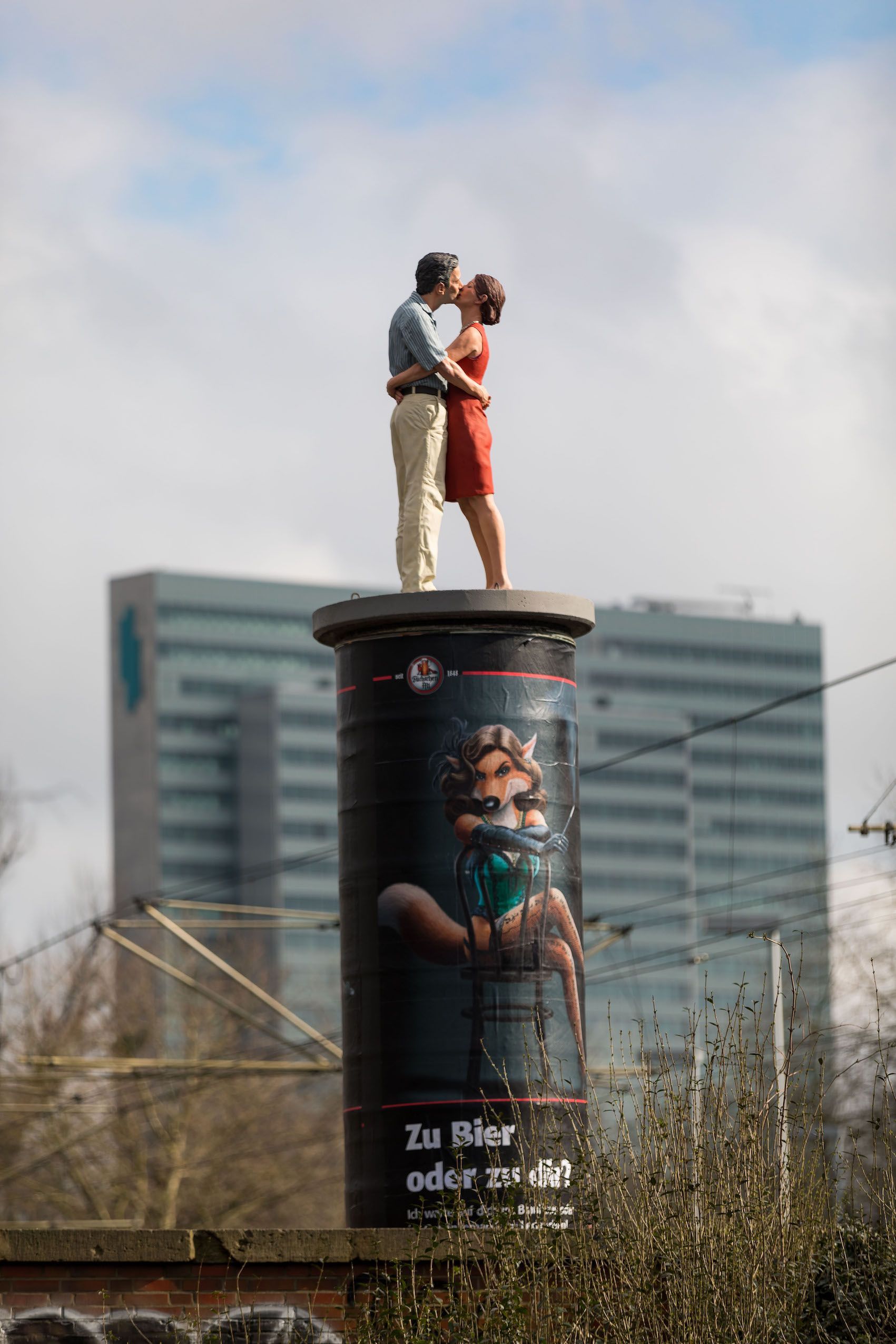
The kiss Christoph Pöggeler © Oliver Look
"In public space, you can immortalise yourself and leave traces."
Through your column saints you are immortalised in the city history of Düsseldorf. What does that mean to you personally?
In public space, you can immortalise yourself and leave traces. Often the pictures disappear after an exhibition in private ownership. Out of the same impulse as with the wooden paintings, I found something I could start with and add to. The Litfass column, like the wooden board in my painting, was a vehicle, a pedestal - a part of the new artwork Pillar Saints. The advertising pillar is a great means of communication because it is a jumble of social or commercial announcements. I thought it was wonderful to combine that with the aspiration to put real-life everyday figures on it. It was a rocky road to get that idea accepted though.
Can you perhaps tell the readers again how you were inspired to create the pillar saints?
The idea came from painting. When I was a student, cars as well as advertising posters and shop windows were very colourful and I painted photorealistic cars, advertising pillars and colourful sculptures in urban spaces. At some point I made a drawing of an advertising pillar and recognised a ballerina on a poster at a dance event. I put her on the advertising pillar in my drawing as a joke. Visitors to my studio from the graffiti scene thought it was great and advised me to do this in public space. I had the impulse to go from dreamy drawing to realising such a project in the city.
What type of person are you interested in? Are the pillar saints people you have met personally?
Most of the figures are people I know personally. Starting with my partner Marlis, whom I immortalised in a holiday photo. Sometimes holiday photos have monumental structures and Marlis mimed a figure with wings in the corner of a Venetian villa where the figure was missing. The businessman is an icon of everyday life that has not looked different since the 1920s, as the dress code is always recognised internationally. With the businessman, it was also a dynamic movement; I wanted to have the active. The photographer is a friend of mine; an artist and painter himself, who helped me a lot in my studio. It was my personal concern to show the constant search for images that embodies our time. Today with smartphones, but I gave the figure a camera to show where this comes from. The image maker that floods our world with thousands of images. For modelling the figures I learned sculpting. I was involved in nude drawing for years, I also taught it, so I knew the anatomy very well. It was easy for me to work figuratively and illusionistically.
Many Düsseldorfers have their favourite column saint. My favourite is the mother and child standing at the Lambertus Church.
On one of my first projects, the beach loungers, I had also painted a Madonna. I am not religious, but it is something extremely emotional. Since religion has taken hold of this emotional theme, mother and child, you find beautiful pictures in churches and museums. But you can also take pictures of your own wife, and it was exactly at this time that we had our second child. The mother and child figure is not meant to create an association with the church. The theme is "The Stranger". It is a Roma woman, a real person. It was important for me to show how she carries the child and looks across the Rhine, as a symbol for a border that can be crossed. "The kiss" are people I know who work in Düsseldorf. A kiss image is always something iconic; an extremely charged, human behaviour. There's something iconic about the bride, because it's the day when you're prince and princess, and it's also a stage in life when a family is formed. The bride is the symbol of the wedding for me, even more than the man.
"I would like to show the themes, homelessness and people on the fringes of society, with extremely little money, who have to be resourceful to cope with all the expenses of life."
What would be your dream for the next Pillar Saints? What would it be - where would you like to see your characters and do you want to reveal it at all?
It is a work in progress. I would like to show the themes, homelessness and people on the fringes of society, with extremely little money, who have to be resourceful to cope with all the expenses of life. Also the theme of old age and also a young person. Deliberately broad, in a respectful way, without becoming genre-like. Also very fond of the theme of physical labour, whether man or woman as opposed to the white collar worker. Maybe this time I wouldn't model by hand, but would go the scanning route.
Can the pillar saints always only stand on advertising pillars? Are there still enough vacancies in Düsseldorf?
It's my unique selling point and there are still a lot of vacancies in Düsseldorf. In the beginning, I took the train through Düsseldorf with my daughter and we counted them. Some are replaced by the luminous turnstiles, especially in the inner city area. But once an old advertising pillar was put up especially for me. I think the cylindrical shape of the concrete rings with the posters and the concrete cover is particularly beautiful.
What is it like to work in public space?
In public space you cross property lines and you have to clarify insurance issues and, for example, permission issues of a conservational nature. I learned a lot when I left my "autistic" picture studio. I learned to talk to people, the pillar company, the advertising company, the city conservator or the state conservator. The most difficult thing was to find sponsors.
" I love the river. For me it's an inspiring part of the city; something that keeps me here."
Do you find inspiration here in the city from the art academy or from the city for which you eventually created a landmark?
I grew up in Trier and Aachen and it's a coincidence that I stayed in Düsseldorf. I love the river. For me it's an inspiring part of the city; something that keeps me here. I find inspiration everywhere in the city.
What projects are you currently working on?
At the moment my work consists of working on wooden panels, also found objects. The column saints exist in miniature format and even in lipstick format. For the first time we have brought them out in a bronze edition. It is 40 cm high, partly painted and partly patinated. It was an idea to send them out into the world now.
Christoph Pöggeler ©Oliver Look
TOP STORIES
CHECK THE THINGS YOU WANT TO THROW AWAY
HA Schult's Trash People at the Circular Valley Forum in Wuppertal on 18 November 2022.
NOVEMBER 19, 2022
_____________________
THE OPERA OF THE FUTURE
Düsseldorf, capital of North Rhine-Westphalia will receive the opera house of the future.
FEBRUARY 15, 2023
_____________________
LONDON
Opening: Lightroom, London's new artist home, shows: David Hockney
DECEMBER 2, 2022
_____________________
FLORENCE
The extraordinary museums of Florence in 2023.
JANUARY 1, 2023
____________________
DÜSSELDORF
DECEMBER 11, 2022
____________________
IN BEAUTIFUL A CORUNA
New exhibition of the Marta Ortega Pérez Foundation: "Steven Meisel 1993" .
DECEMBER 5, 2022
____________________
WORLDLEADER
How did ProWein manage to become No. 1 in contrast to other international trade fairs.
MARCH 15, 2023
____________________
INTERNATIONAL TOGETHERNESS
MARCH 8, 2023
____________________
TRAVEL
What major events in art, culture and society are we facing?
JANUARY 21, 2023
____________________
Hollywood
____________________
DISTANT WORLDS
Dieter Nuhr's paintings now in Senegal - "A Nomad in Eternal Transit"
DECEMBER 6, 2022
Christoph Pöggeler © Oliver Look
Eisberg - IV- 2009 @Christoph Pöggeler





